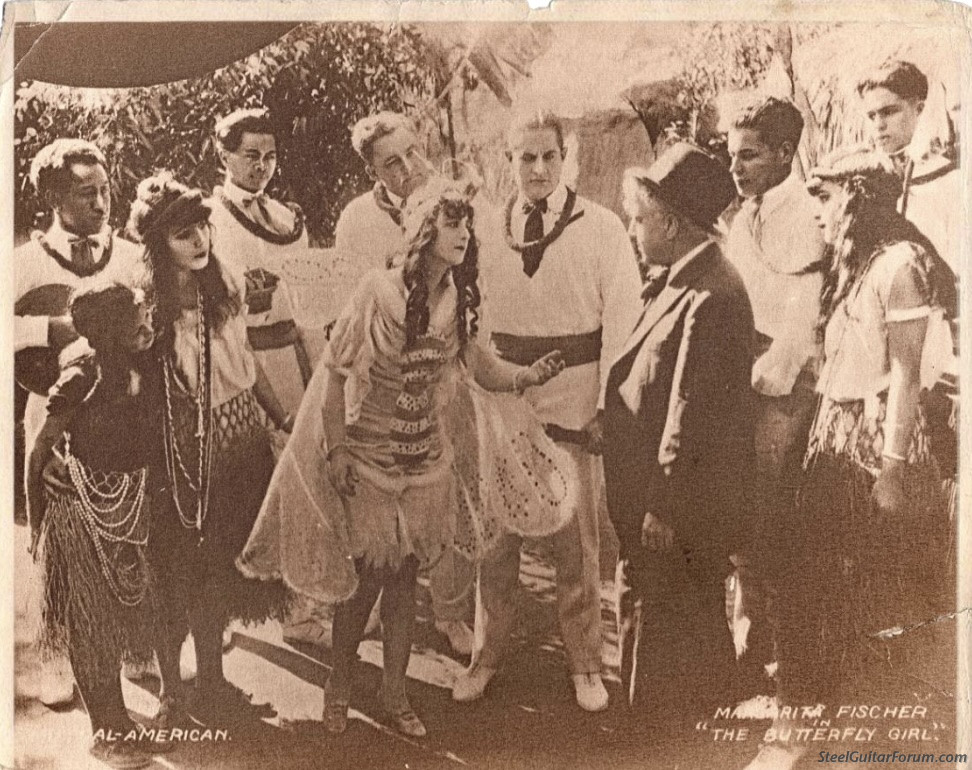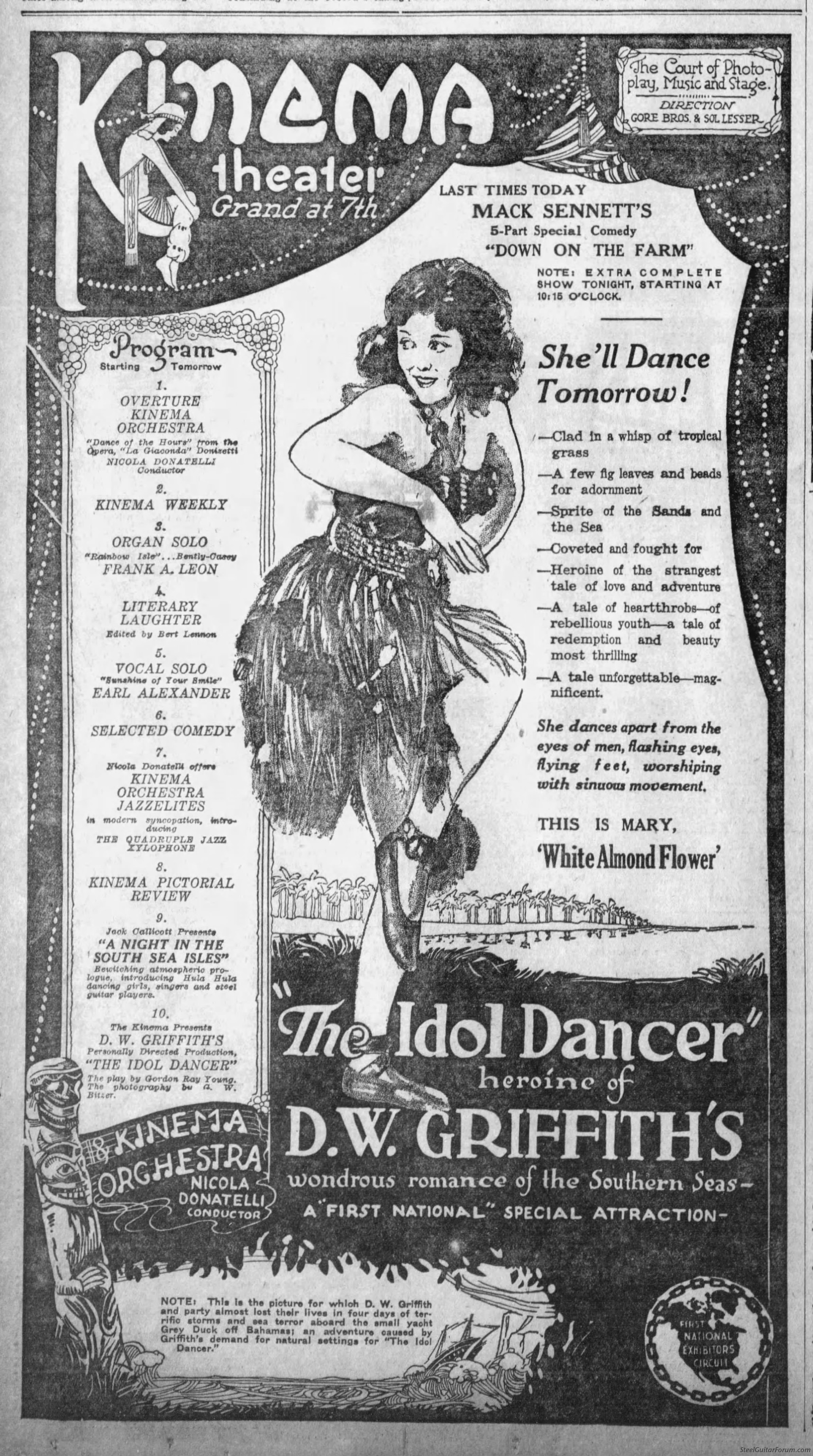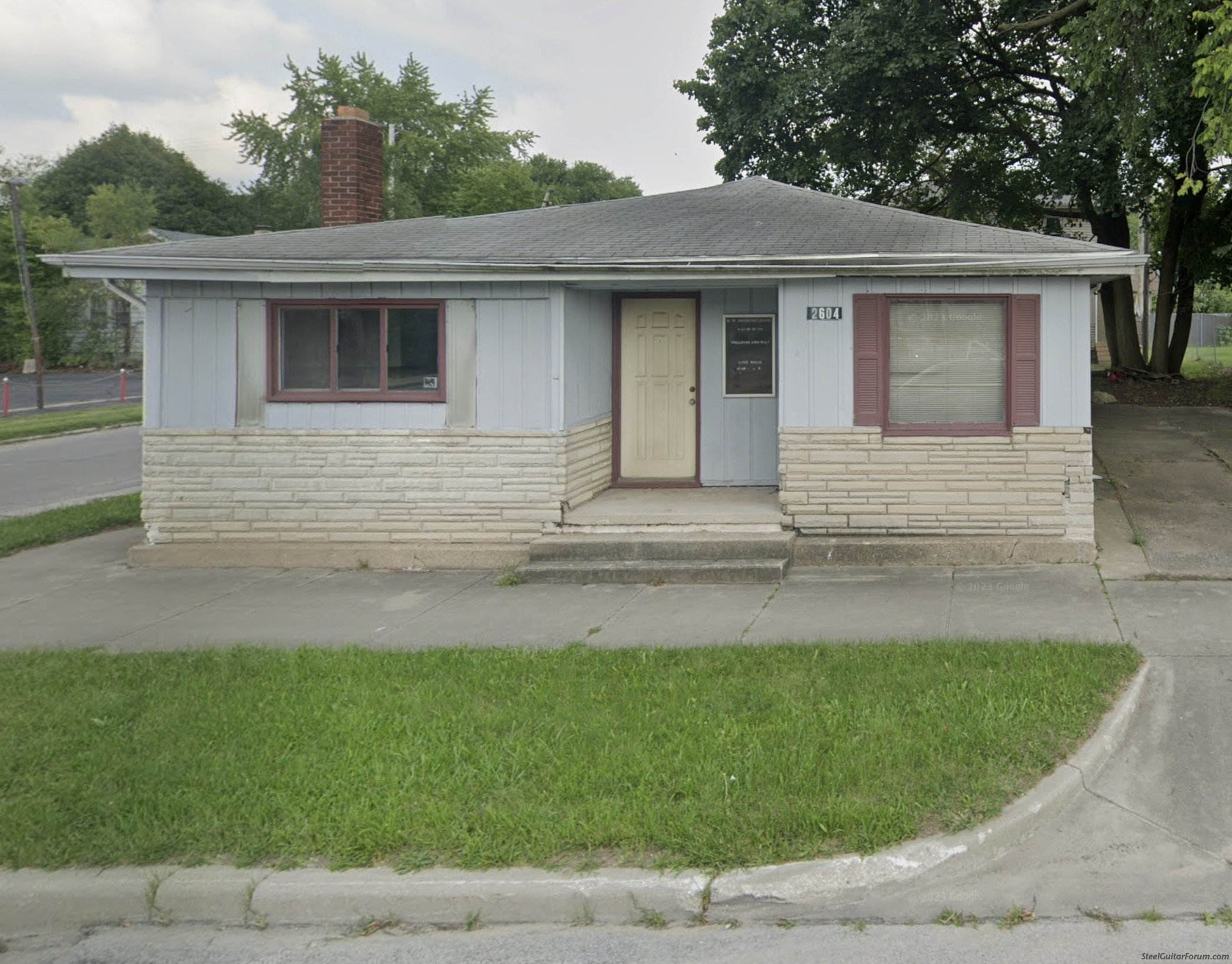robert kramer
From:
Nashville TN
|
 Posted 7 Sep 2024 7:19 am
Posted 7 Sep 2024 7:19 am |
|
Pt #2 "Moving Images Of The First Steel Players To Work Nashville"
This is a follow-up to a follow-up to John Norris's "Topic: 1930s & 40s recordings featuring Letritia Kan.
John Norris, Steel Guitar Forum, August 12, 2024.
https://bb.steelguitarforum.com/viewtopic.php?t=189598
Part #2 "Moving Images of the First Steel Players to Work Nashville"
The first steel players to perform in Nashville were native-born Hawaiians working the Vaudeville circuits booked in at the 10-cent Vaudeville houses downtown. Three of these steel players also appeared in movies: Eddie Shaw ("The Butterfly Girl," 1917, "The Hawaiian Love Call," 1929, "Hawaiian Romance," 1930), Walter K. Kolomoku ("Idol Dancer," 1920), and Robert Matsu ("Hawaiian Nights," 1927). Three of these movies were shown in Nashville: "Idol Dancer," "Hawaiian Nights," and "The Hawaiian Love Call." These films might have influenced local steel players who had started or would be soon starting entertainment careers of their own. Two of these movies have survived.
EDDIE SHAW
Eddie Shaw played a bit part in "The Butterfly Girl," a silent photoplay starring Margarita Fischer released on January 8, 1917. Also cast were his father, James; younger sisters, Jonia, Esther, and Wini; and his brother, George. Tragically, this film is considered lost, and only a single still image remains showing Eddie Shaw standing directly to the right of the man in the top hat and Jonia third from the right. "Jonia, The Pearl of Hawaiia and Her Hawaiians" was a family band with Eddie Shaw on steel, active from 1917 to 1928, and became one of the most successful Hawaiian acts of their day.

© Winifred Matteson Archive
In 1929, Eddie Shaw and his younger sister, Esther, appeared in the Vitaphone Talking Picture, "The Hawaiian Love Call." In September 1930, they starred in "Hawaiian Romance," another Vitaphone talkie. "Hawaiian Romance" was filmed in September 1930 at the RCA Victor Laboratory in the Trinity Baptist Church at 114 N. 5th Street in Camden, New Jersey, where two and a half years earlier, on Tuesday, February 15, 1928, Ellsworth C. Cozzens played Hawaiian steel guitar on "Blue Yodel No. II (My Lovin' Gal Lucille)," Jimmie Rodger's first recording to use steel. A year later, on Thursday, February 14, 1929, in the same studio, Maybelle Carter took a rare turn on Hawaiian guitar, tuning her Stella Concert down to an Island chord to cut The Carter Family's "Sweet Fern." Sadly, both "The Hawaiian Love Call" and "Hawaiian Romance" are considered lost. Two still images from "Hawaiian Romance" survived, showing Esther dancing the Hula Hula while Eddie backs her up on what appears to be a National Tricone.

© Winifred Matteson Archive

RCA Victor Laboratory, Trinity Baptist Church, 114 N. 5th St., Camden, NJ
(Evening Courier, September 19, 1930, Camden, NJ)
WALTER K. KOLOMOKU
In 1920, Walter K. Kolomoku played steel guitar in the silent film "Idol Dancer," starring Clarine Seymour as "Mary" a very enticing Island maid called the "White Almond Flower," with whom the "Blood of vivacious France, inscrutable Java, and languorous Samoa, mingle in her veins." (Brooklyn Eagle, March 30, 1920). "Idol Dancer" survived and is available on YouTube.
Walter K. Kolomoku: stl gtr @ 40:34 - 41:12
"The Idol Dancer (1920)," YouTube.
https://www.youtube.com/watch?v=6lJvRhPqQCo&t=2586s

(Los Angeles Evening Express, April 24, 1920, Los Angeles, CA)
"The Idol Dancer," 1920, "Hawaiian Nights," 1929, and "Hawaiian Love Call," 1929, were all shown in Nashville in the same downtown Vaudeville theatres that had featured these same native Hawaiian troupes. In June 1920, "The Idol Dancer" also played at the Oliver Theatre on North Main in South Bend, Indiana. Ten minutes away and 29 years later, an 11-year-old 5th grader, Buddie Emmons, would sign up for Hawaiian steel guitar lessons at the Honolulu Conservatory of Music on South Michigan Street.

Image of Walter K. Kolomoku lower left-hand corner (The South Bend Tribune, June 9, 1920, South Bend, IN)

Honolulu Conservatory of Music, 2604 South Michigan Ave. South Bend, IN (former location)
Walter K. Kolomoku worked out of New York City and, by 1925, was broadcasting over the radio and operating the Hawaiian Conservatory of Music, posting advertisements in newspapers around the country for correspondence courses on Hawaiian guitar.

(The Kentucky Post, March 7, 1925, Covington, KY)
Down in Houston, Texas, Bob Dunn mailed away to New York City for these lessons. On January 27, 1935, Dunn plugged in his Martin Flattop to record steel with Milton Brown and his Musical Brownies for Decca Records at the American Furniture Mart Building on Lake Shore Drive in Chicago. A year and eight months later, on September 29, 1936, Bob Wills, with Leon McAuliffe on steel, would cut "Steel Guitar Rag" for Vocalion at the same studio.

American Furniture Mart Building, 666 Lake Shore Drive, Chicago, IL
ROBERT MATSU
Robert Matsu played twin steels with Mike Halapi with Kalama's Hawaiian Quartet in the 1927 Vitaphone short "Hawaiian Nights," which also survived and is available on YouTube.
Mike Halapi is in the center, and Robert Matsu is to his right:
"Hawaiian Nites, February ***1923 (***mislabeled - the correct year is 1927) Vitaphone, Kalama's Quartet," YouTube.
https://www.youtube.com/watch?v=aET8xfK85HQ (accessed August 27, 2024)
"The Idol Dancer" and "Hawaiian Nights" are the only surviving footage of any of the early Hawaiian steel players performing in Nashville. These few silent frames remain essential to the history of the steel guitar. For all we might think today of our "advancements" in the sound and technology of the steel guitar, perhaps there's also perspective to be gained by going back to the early 1900s to see and hear the steel players who performed in a city that, within 50 years would become the center of steel guitar development.
WINI SHAW performing "LULLABY OF BROADWAY" in "GOLD DIGGERS OF 1935"
Scrolling back up to the movie still from "The Butterfly Girl," the young girl to the far left is Eddie Shaw's younger sister, Wini Shaw. When Jonia Shaw, "The Pearl Of Hawaii," died tragically at 21, bookings for "Jonia, The Pearl Of Hawaii and Her Hawaiians" were already under contract. A 14-year-old Wini Shaw stepped in as the new "Jonia," continuing the act's very successful Vaudeville career. After the Shaw family band disbanded in 1928, Wini Shaw performed under her own name as a nightclub singer, dancer, stage and screen actress, appearing in 29 films. In 1935, Wini introduced the song "Lullaby of Broadway" in the 1935 film "Gold Diggers 1935," directed by Busby Berkeley for Warner Brothers. "Gold Diggers 1935" was first shown in Nashville in June 1935 at the Knickerbocker Theatre downtown on 6th Avenue North, just blocks away from where her sister, "Jonia, The Pearl of Hawaii," had danced and Eddie Shaw had played steel 20 years before.
Wini Shaw at 14

© Winifred Matteson Archive
Wini Shaw at 28:
Gold Diggers of 1935 - Part 1 of "Lullaby of Broadway"
https://www.youtube.com/watch?v=34KAShRPWCo
Gold Diggers of 1935 - Part 2 of "Lullaby of Broadway"
https://www.youtube.com/watch?v=RiZOa6ITj44
Gold Diggers of 1935 - Part 3 of "Lullaby of Broadway"
https://www.youtube.com/watch?v=tTgcMzRdmBY
Last edited by robert kramer on 9 Sep 2024 7:18 am; edited 4 times in total |
|




